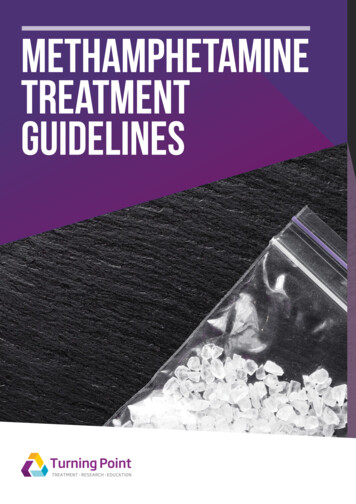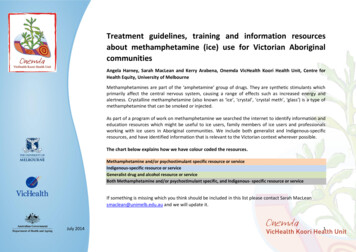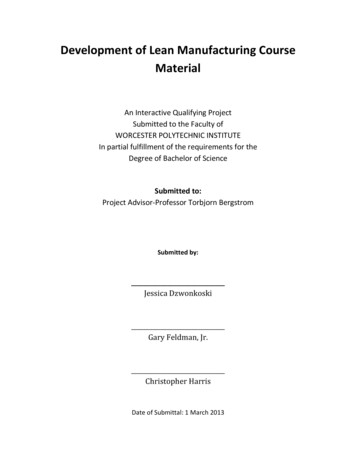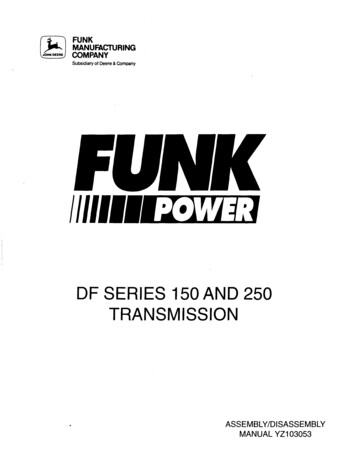
Transcription
Clandestine MethamphetamineManufacturing:1) Methods of Meth Synthesis2) Understanding Lab Reportsand Chemical Evidence Lists3) Errors Made by Forensic LabsEdward G. Brown, Ph.D.Brown’s Chemistry Servicesed.brown@earthlink.net
1) Methods of MethamphetamineSynthesis
Methamphetamine Manufacturing: Two Primary Routes for Synthesis of Meth Usedby Clandestine Laboratories in the USA:– A) Pseudoephedrine Route Precursor is Sudafed from the drug store andinvolves the use of reducing agents like hydrogenor hydrogen iodide and red phosphorus.– B) Phenyl Acetone Route Precursors are phenyl acetone or P2P, methylamine and reducing agents.
Methamphetamine Manufacturing:Pseudoephedrine Route: Substances that can be found at a laboratorythat used this route:-- Pseudoephedrine or ephedrine;-- Hydrogen iodide and red phosphorus; or-- A special metal catalyst like palladium, platinum orrhodium and a source of hydrogen gas;-- Hydrochloric acid;-- Organic solvents like ether, benzene, chloroform,kerosene or white gas; and-- Lye or washing soda.
Methamphetamine Manufacturing:Pseudoephedrine Route:
Methamphetamine Manufacturing:Phenyl Acetone Route: Substances that can be found at a laboratory thatused this route:-- Phenyl acetone;-- Methyl amine or methyl amine hydrochloride;-- Formaldehyde, ammonia;-- Hydrochloric acid;-- Aluminum foil, mercuric chloride;-- Organic solvents like ether, benzene, chloroform,kerosene or white gas; and-- Lye or washing soda.
Methamphetamine Manufacturing:Phenyl Acetone Route (2): In addition, if the phenyl acetone precursorneeds to be synthesized first, then othersubstances that can be found at a laboratory mayinclude:-- Magnesium turnings;-- Benzyl chloride or benzyl bromide;-- Sodium cyanide or acetic anhydride;-- Ether or tetrahydrofuran; or-- Phenylacetic acid and thorium oxide.
Methamphetamine Manufacturing:Phenyl Acetone Route:
Similarities and Differences Betweenthe Two Methods of Manufacture: The Phenyl Acetone/ Methyl Amine routerequires a source of phenyl acetone (whichmay need to be synthesized from otherstarting materials or purchased from anothersource), methyl amine and a reducing agentsuch as aluminum amalgam for the first step. This reduction procedure produces a productthat is a 50: 50 mixture of two isomers (the d, and l- isomers) of methamphetamine.
Similarities and Differences Betweenthe Two Methods of Manufacture: The ephedrine/ pseudoephedrine route requiresa source of the ephedrine or pseudoephedrine(usually from the drug store) and a reducingagent (like red phosphorus and hydrogen iodide;or hydrogen gas and a metal catalyst). This reduction starts with a material that is madeup of one naturally-occurring isomer andproduces a material that is also one isomer (thed-isomer only) rather than a 50: 50 mixture of dand l-isomers, in contrast to the P2P process.
Similarities and Differences Betweenthe Two Methods of Manufacture: For both reaction sequences, once the crudemethamphetamine product is made, thepurification processes are similar and requirevarious acids (like hydrochloric acid or sulfuricacid), bases (like lye or washing soda) andsolvents (like toluene, kerosene or ether) toseparate the methamphetamine product fromother reaction products.
Similarities and Differences Betweenthe Two Methods of Manufacture: Both processes usually have a final step that usesgaseous hydrogen chloride to produce thehydrochloride salt of methamphetamine as awhite solid from a solvent solution ofmethamphetamine free base. The waste products from the two methamphetamine synthesis processes differ in the exactchemical make up of the wastes, but there aresome similarities, too.
Similarities and Differences Betweenthe Waste Products of Manufacture: Typically, meth can be manufactured using flasks andother scientific equipment or it can be produced bysimply using quart jars, gallon jugs and coffee filters. After a procedure has been used to make meth, whatremains (in addition to the final meth hydrochlorideproduct) are solutions of chemical waste. Onecontainer has a solution of highly acidic water (pH 1 orless), another has a solution of highly basic water (pH 14or more), and a third has waste solvent in it. There arealso usually one or more filter papers used and left over.Not all filter papers are contaminated withmethamphetamine and should be analyzed separately.
Meth Manufacture Summary: There are two main methods used to manufacturemeth, and each method has variations on theprocedures used. The primary product from both these variations ismethamphetamine hydrochloride, not the freebase. The P2P/Methyl amine method produces a product thathas two isomers (d- and l- isomers) present in equalamounts. The Sudafed route produces a product thathas only one isomer present (the d- isomer). Both routes produce chemical wastes. Some of thesewaste materials are contaminated with meth and othersare not.
2) Understanding Lab Reportsand Chemical Evidence Lists
Understanding Lab Reports andChemical Evidence Lists Usually, when the discovery evidence is presented toa defense attorney, it consists of: A Summary Chemical Analysis Report– This is a document from a chemistry laboratory thatstates if controlled substances were detected or not invarious evidence samples. A Police Property Report– This document lists evidence samples confiscated,weights of materials found, locations where chemicalevidence was discovered, etc.– Also lists opinion of officer about what the pieces ofevidence consist of.
Understanding Lab Reports andChemical Evidence Lists Although the analysis report and police propertyreport are somewhat useful to a defense expert, themost useful documents are usually not included inthe initial discovery package; these include: A Copy of the Lab Analyst’s Laboratory Notebook:– This is a hand-written document from a chemistrylaboratory that shows what an analyst did to test theevidence samples. A Copy of Each GCMS-, LCMS-, FTIR-Printout:– These documents show the machine printouts from theanalytical analyses. They can be analyzed to see if thecorrect procedures were followed or not.
Understanding Lab Reports andChemical Evidence Lists Copies of Other Chemical Evidence Tests thatwere Run by the Forensic Analyst:– These are sometimes hand-written documents and atother times they are typed up summaries. They showwhat other tests that an analyst did to test theevidence samples. A Copy of the Laboratory’s Standard OperatingProcedures:– These documents show the procedures that theanalysts must follow in order to correctly andunambiguously show that controlled substances weredetected in the analyst’s experiments.
Understanding Lab Reports andChemical Evidence Lists
Understanding Lab Reports andChemical Evidence Lists
3) Errors and Incorrect AssumptionsMade by Forensic Labs in ChemicalEvidence Evaluation:
Analytical Testing: BackgroundAnalytical Tools & Methods Commonly Employedin Drug Cases: Presumptive Tests:-In medical and forensic science, a presumptivetest is an analysis of a sample which establisheseither:-The sample is definitely not a certainsubstance.-The sample probably is the assumed substance.-Presumptive tests include: color tests,
Analytical Testing: BackgroundAnalytical Tools & Methods Commonly Employedin Drug Cases: Confirmatory Tests:-Tests required to confirm the analysis.-Confirmatory tests cost more than simplerpresumptive tests, which is why presumptivetests are often made to see if confirmatorytests are necessary.-Confirmatory tests include GCMS analyses,LCMS analyses, Infrared Spectroscopy analyses.
Assumption Errors Made by Forensic Labs: The forensic analyst relies on the labels of bottlesand jars to “prove” the identity of the chemicalsinside; This is a flawed assumption; Labels do not prove the identity of substancesinside the containers; An expert witness can give an opinion to showthat point in court.
Assumption Errors Made by Forensic Labs: An analyst performs a presumptive test on yourclient’s evidence sample but does not perform aconfirmatory GCMS test on the evidence. This analyst assumes that the presumptive testevidence proves the presence of a scheduled drug. This is an incorrect assumption on the part of theanalyst. Presumptive tests are only a first step; they hint thatthere may be a certain substance present; it doesnot prove that the evidence shows the presence of asubstance. One or more confirmatory tests are required toshow that the actual substance is present in thesample.
Assumption Errors Made by Forensic Labs: A forensic analyst assumes that a number of samples ofwhite powder pertaining to your client’s evidence allcontain a scheduled substance; Rather than running separate analyses on the individualsamples, the analyst combines all these samples and runsjust one confirmatory analysis on the combined sample. When a scheduled substance is found in this combinedsample, the analyst assumes that each sample containedthe substance and attributes the entire weight of thecombined samples to your client. This assumption is flawed; the substance has not beenproven to be in each of the samples separately, so thetotal weight of the combined samples cannot be used togive a weight for the penalty phase of the case.
GCMS Errors Made by Forensic Labs: A blank sample is not run immediately before yourclient’s sample; Cross-contamination by a previous sample run froman unrelated case is possible; The analyst has not “proven” that the peak fromevidence in the GCMS from your client’s sample isdue exclusively to your client’s sample; Contamination from a dirty injector needle in themachine from may have occurred; The meth product that was detected in your client’ssample may actually be from another evidencesample from a previously-injected evidence sample.
GCMS Errors Made by Forensic Labs: A validated sample of the controlled substance isnot analyzed immediately after your client’ssample on the GCMS instrument; Retention times and MS fragmentation patternsof compounds can vary slightly on a GCMSinstrument over time, your client’s sample maybe an isomer or closely-related material to thecontrolled substance without being the actualcontrolled substance itself; A chemistry expert can testify to this point incourt.
GCMS Errors Made by Forensic Labs: Under certain conditions, pseudoephedrine andephedrine can be decomposed on the hot injectorport of a GCMS instrument to form a small amountof methamphetamine. In these cases, themethamphetamine is being created by the analysistechnique, even though it is not present in thesample that is being analyzed. Sometimes a forensic analyst makes the incorrectassumption that there is a small amount ofmethamphetamine present in the analyzed sample. A chemistry expert is able to determine if this hasoccurred in your client’s case or not.
GCMS Errors Made by Forensic Labs: Under certain conditions, pseudoephedrine andephedrine can be decomposed on the hot injectorport of a GCMS instrument to form a small amount ofmethamphetamine. In these cases, themethamphetamine is being created by the analysistechnique, even though it is not present in thesample that is being analyzed. This is a false-positive. Sometimes a forensic analyst makes the incorrectassumption that there is a small amount ofmethamphetamine present in the analyzed sample. A chemistry expert is able to determine if this hasoccurred in your client’s case or not.
MS Printout of False Positive
MS Printout of False Positive
Summary of Analytical Section: Chemists use a variety of tests to analyze evidencesamples. Some are presumptive tests and some are confirmatorytests. Presumptive tests are only meant to show possibilities;they are not proof that a certain substance is present.They can produce false-positives. Confirmatory tests are required to prove that a substanceis present. But even then, there can be false-positives orfalse conclusions drawn. There are a number of ways that forensic labs can makemistakes when analyzing chemical evidence. An expert for the defense can come to differentconclusions than the prosecution experts when analyzingthe same evidence samples because the defense expertcan see where errors have been made or are possible.
Thank you!
Methamphetamine Manufacturing: Pseudoephedrine Route: Substances that can be found at a laboratory that used this route:--Pseudoephedrine or ephedrine; -- Hydrogen iodide and red phosphorus; or










